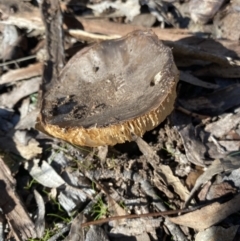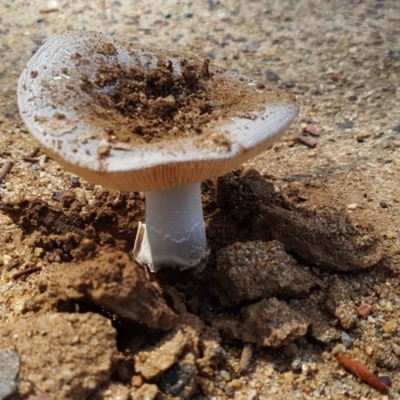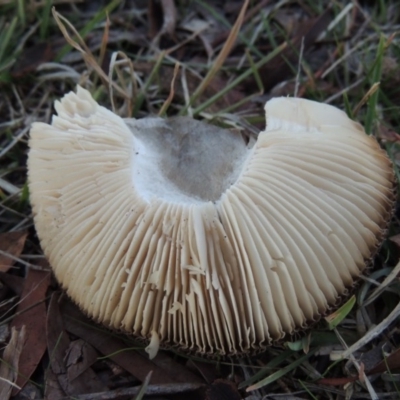Amanita sp. (Amanita sp.)
The fruit body is a mushroom with a cap on a central stem. Caps and stems vary greatly in size and colour. The gills are white in almost all species (some have pale pink, yellowish or green gills).
The gills are free (none reach the stem). Around the top of the stem there is a circular furrow, as in this photo of another genus: http://www.cpbr.gov.au/fungi/images-captions/agaricus-sp-0037.html.
Few genera have free gills so it is a very informative feature.
Warning: When a mushroom starts drying, in those species without free gills the gills may tear away from the stem and appear free. Always be suspicious when you think you’ve seen free gills. Check carefully for signs of tearing, especially if the cap shows any signs of the wrinkling that comes with drying.
A partial veil that covers the gills in an immature mushroom may be present, the remnant left as a weak or well-developed ring of tissue around the stem of a mature mushroom.
All species have a universal veil (a membrane that envelopes the button stage). Traces may be left on the cap as random warts or patches or at the stem base as a volva. At one extreme, a volva is a well-developed cup around the base; at the other just a ring of tissue or scales around the base. Very few genera have a volva, so it is highly informative but often it is largely buried.
Spore print: white.
The mushrooms appear on the ground, near trees, in a many habitats.
Look-alikes
Most species of Lepiota s.l., Macrolepiota and Chlorophyllum have free, white gills and white spores and all have a partial veil but lack the universal veil. These lepiotoid mushrooms usually have scaly caps, with the scales often of a colour different to that of the underlying flesh. The scales are not randomly scattered but are densely packed near the centre of the cap (giving a solid patch of colour there) and sparser and sparser as you move outward. Often this gives the appearance of concentric rings of scales.
About Amanita
The stated aim of http://www.amanitaceae.org/ is “a monographic level treatment of the Amanitaceae with facts and data accessible to persons of multiple levels of interest and expertise”. It deals with Amanitaceae worldwide, drawing information from numerous publications. The species’ descriptions are useful and are summaries of the more detailed descriptions originally published in botanical or mycological journals.
Amanita sp. is listed in the following regions:
Canberra & Southern Tablelands | Albury, Wodonga | South Coast | Greater Sydney | New South Wales North Coast | Hume | Gippsland | Greater Brisbane
1 2
Species information
- Amanita sp. Scientific name
- Amanita sp. Common name
- Not Sensitive
- Local native
- Non-invasive or negligible
- Up to 1400.19m Recorded at altitude
- Machine learning
-
In flower
Location information
-
Maps
ANBG Aranda Bushland Bicentennial Park Black Mountain Bluetts Block (402, 403, 12, 11) Boro Bruce Ridge Bullen Range Burrinjuck Nature Reserve Callum Brae Cantor Crescent Woodland, Higgins Cooma North Ridge Reserve Dryandra St Woodland Farrer Ridge Federal Golf Course Gidleigh TSR Ginninderry Conservation Corridor Googong Foreshore Goulburn Mulwaree Council Gungaderra Grasslands Higgins Woodland Hughes Garran Woodland Hughes Grassy Woodland Isaacs Ridge and Nearby Lake Ginninderra Lake Tuggeranong Mongarlowe River Mount Painter Mount Taylor Namadgi National Park National Arboretum Forests Nunnock Swamp Piney Ridge Red Hill Nature Reserve Red Hill to Yarralumla Creek South East Forest National Park Sth Tablelands Ecosystem Park Stranger Pond Sweeney's TSR The Pinnacle Tidbinbilla Nature Reserve Umbagong District Park Wanna Wanna Nature Reserve Wanniassa Hill Woodstock Nature Reserve -
Places
Borough, NSW Captains Flat, NSW Cotter River, ACT Denman Prospect, ACT Glen Allen, NSW Higgins, ACT Isaacs, ACT Mongarlowe, NSW Yarralumla, ACT













































































































































































































